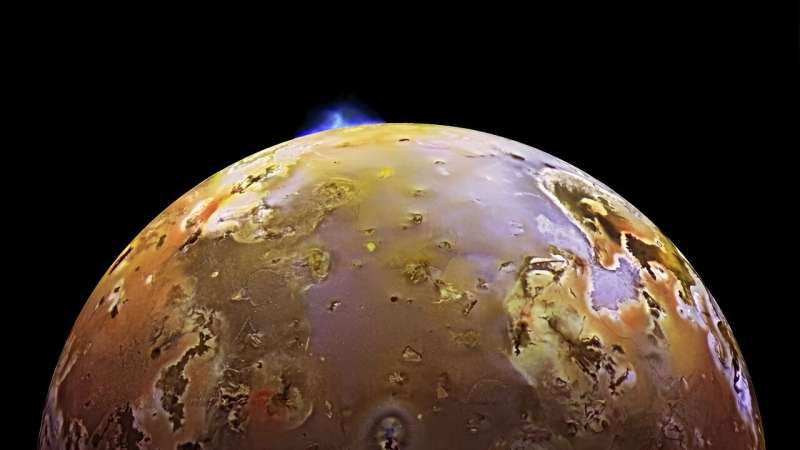This article has been reviewed according to Science X's editorial process and policies. Editors have highlighted the following attributes while ensuring the content's credibility:
fact-checked
preprint
trusted source
proofread
Io has 266 active volcanic hotspots linked by a global magma ocean, finds study

Jupiter's Io stands apart from the solar system's other moons, with its numerous volcanoes and its surface dominated by lava flows. Io's surface volcanism was confirmed in 1979 when the Voyager spacecraft imaged it, but its volcanic nature isn't duplicated anywhere else in our system. Tidal heating is behind the moon's eruptive nature, driven by Jupiter's powerful gravity, and by resonance with other moons. But is there a magma ocean inside Io?
A final answer to that question has been elusive, but new research supports the idea of a magma ocean.
NASA's Juno mission has shifted its focus from Jupiter to the gas giant's moons, beginning with the volcanic Io. It's flybys are getting increasingly closer to the unique moon, and the decreasing distance is giving the spacecraft a better and better look. It's identified 266 active volcanoes, and together, they're evidence of a vast global ocean of magma according to new research.
A new study posted to the arXiv preprint server titled "Io's polar volcanic thermal emission indicative of magma ocean and shallow tidal heating models" presents these results. The lead author is Ashley Gerard Davies from NASA's Jet Propulsion Laboratory. "The extreme level of volcanic activity on Io, the most volcanically active object in the solar system, is the result of tidally induced internal heating," the authors write. That's not a new conclusion, but there's more to the research.
Juno's Jovial Infrared Auroral Mapper (JIRAM) instrument acquired the data behind this research. JIRAM is an image spectrometer, and was designed to probe Jupiter's upper atmosphere in infrared, including the giant planet's auroral regions. But now the focus has shifted to Io, and JIRAM is observing the moon's widespread volcanic activity.
"Io is the most volcanic celestial body that we know of in our solar system," said Scott Bolton, Juno principal investigator from the Southwest Research Institute in San Antonio. "By observing it over time on multiple passes, we can watch how the volcanoes vary—how often they erupt, how bright and hot they are, whether they are linked to a group or solo, and if the shape of the lava flow changes," Bolton said in May 2023 when Juno came within about 35,500 km (22,000 miles) of Io.
Since then, Juno has closed the distance even more, and its latest pass brought it to within 12,000 km (7500 miles.) But it's not just the proximity that is driving more discoveries. Juno follows a polar orbit, while previous observations of Io have been mostly confined to an equatorial plane. Why does that matter?
Scientists have been studying Io intently, trying to discover what drives its volcanic nature. They've developed detailed models of the moon, but haven't been able to test them as rigorously as they can now. "Models predict enhanced heat flow at Io's poles if tidal heating is deep in the mantle, and at lower latitudes if heating is predominantly in the asthenosphere, or a magma ocean is present," the authors explain.
But now scientists have Juno's data to work with, and its polar orbit is giving researchers a more complete look at the moon.
"The distribution of Io's volcanic activity likely reflects the position and magnitude of internal tidal heating," the authors write. Now that JIRAM has provided polar data, researchers have complete, global near-infrared coverage that reveals the distribution and the magnitude of thermal emission from Io's actively erupting volcanoes. With that data, the researchers can probe the moon's interior and models developed to explain it.
The research uncovered differences in energy output between the poles and the more equatorial regions, and between the poles themselves. "On average, Io's polar volcanoes individually generate less energy than volcanoes at lower latitudes; and the south polar volcanoes generate less energy per volcano than the north polar volcanoes," the researchers explain.
Why are these findings significant? It's because of previously developed models.
"We show that the distribution of volcanic heat flow from 266 active hot spots is consistent with the presence of a global magma ocean, and/or shallow asthenospheric heating," the authors write.
This isn't the first study to suggest that Io has a magma ocean. Previous research from 2009 based on Galileo's magnetometer data showed that the moon must have a magma ocean about 50 km (30 mi) below the surface. But Galileo only did one flyby of the moon, leaving room for some doubt to creep in. More recent analysis of the same data strengthened the same conclusion, showing that the magma ocean is 50 km thick.
But there was always a little doubt cast on those conclusions because they lacked global infrared data. Now that scientists have that data, the case for a magma ocean is solidifying.
More information: Ashley Gerard Davies et al, Io's polar volcanic thermal emission indicative of magma ocean and shallow tidal heating models, arXiv (2023). DOI: 10.48550/arxiv.2310.12382
Journal information: arXiv
Provided by Universe Today





















